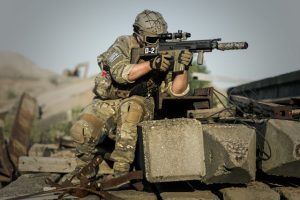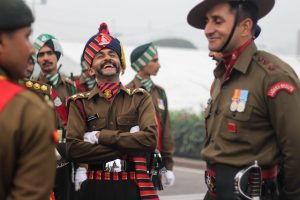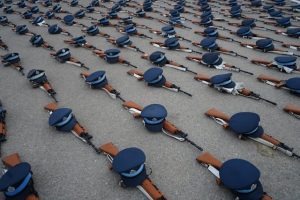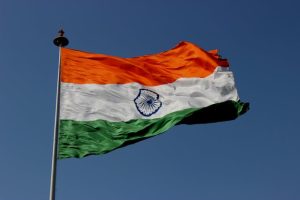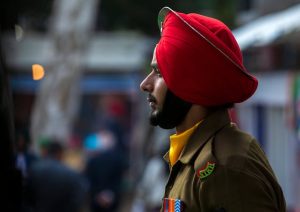A Beginner’s Guide To Joining The Indian Army in 2024
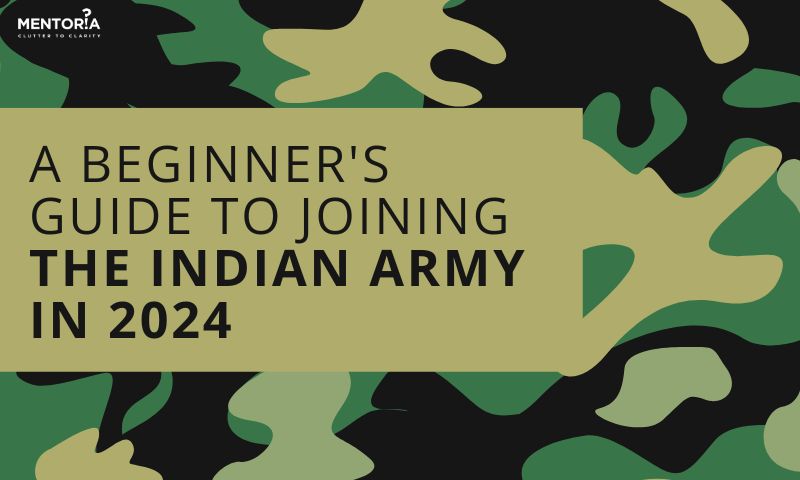
Jump to Section
Superheroes with extraordinary abilities are undeniably impressive, but the real heroes of our nation are the ones who courageously defend our borders, safeguarding the entire country with unwavering dedication and passion. Yes, I’m talking about the brave individuals serving in the Armed Forces, who lead a life filled with thrilling experiences unlike any other.
If you have a deep desire to serve our magnificent country, don the prestigious uniform, and embrace an extraordinary journey, then dive into our blog to discover the path of becoming an Indian Army Officer, explore the salary prospects, and uncover a wealth of other valuable information.
Indian Army: A Closer Look
The Indian Army, founded on April 1, 1895, is the ground-based division of the Indian Armed Forces. It stands as one of the largest armies worldwide, with its main duty being the protection of the nation’s borders against external threats, maintaining internal peace and security, and providing aid during natural disasters and emergencies.
To efficiently carry out its tasks, the army is divided into multiple commands, each assigned to a specific geographical area. It encompasses various branches such as infantry, artillery, armoured corps, engineers, signals, and more, each specialising in different aspects of land-based warfare. The Indian Army is renowned for its remarkable courage and bravery, playing a vital role in safeguarding our nation’s security. The men of the army have been honoured and decorated for their exceptional valour in numerous actions and battles.
Eligibility Criteria For Different Posts
National Defence Academy
- Qualification: Finished 12th grade in the 10+2 format of School Education or a similar exam administered by a State Education Board or a University with 40%- 50% Marks.
- Age Limit: between the ages of 16 ½ and 19 ½
- Gender: Only unmarried male candidates can apply to this exam.
Technical Scheme Exam
- Qualification: Eligible candidates for this entrance are those who have passed the 10+2 Exam or its equivalent and have earned at least a 70% cumulative grade in Mathematics, Physics, and Chemistry from accredited education boards.
- Age Limit: A candidate must not be below 16½ years and above 19½ year
- Gender: Only Unmarried Male candidates can apply.
Army Cadet College
- Qualification: 10+2 from Recognised University.
- Age Limit: Between 20-27.
Indian Army Rally
Qualification
- Soldier Technical: 10+2 with Science (PCME) minimum 50% or equivalent.
- Veterinary: 10+2 with Science (PCME) minimum 50% or B.Sc (Botany/Zoology/Bio-science) and English.
- Soldier Clerks/SKT: 10+2 with a minimum of 60% and should have studied English and Mathematics/Accounting/Bookkeeping with a minimum 50% of marks.
- Soldier Technical (Ammunition Examiner): 10+2 with Science (PCME) minimum 50% or three-year diploma in Engineering (Mechanical/Electrical/Automobile/Computer Science and Electronic & Instrumentation).
- Soldier GD: Matric with minimum 33% or equivalent.
- Soldier Nursing Assistant/Soldier Tradesmen (All Arms): 10th / ITI in relevant trade.
- Soldier Tradesmen: 8th pass.
Age Limit:
- Soldier General Duty: between October 1999 to 1 April 2003
- For Others: between October 1997 to 1 April 2003
Top Branches In The Indian Army
The Indian Army is renowned worldwide for being one of the largest and most respected military forces. It consists of various branches that serve different purposes and functions. Let’s take a look at the main branches of the Indian Army:
- Infantry: The backbone of the Indian Army, infantry units are responsible for ground combat. They engage in close combat and operate in diverse terrains such as mountains, deserts, and plains.
- Armored Corps: The Armored Corps operates tanks and other armoured vehicles, playing a vital role in providing firepower and mobility to ground forces.
- Artillery: The Artillery Corps utilises various artillery guns, rocket launchers, and missile systems to provide long-range firepower. They support infantry and armoured units during combat operations.
- Mechanised Infantry: These infantry units are mounted on armoured personnel carriers (APCs), offering mobility and firepower to infantry forces.
- Engineers: The Corps of Engineers provides engineering support to the Indian Army. They construct bridges, roads, and other infrastructure, as well as clear obstacles and mines.
- Signals: The Corps of Signals ensures seamless communication between different units by operating and maintaining communication systems.
- Army Aviation Corps: The Army Aviation Corps operates helicopters for multiple roles, including troop transport, reconnaissance, and close air support.
- Army Service Corps: The Army Service Corps provides logistical support, including transportation, supply, and equipment maintenance.
- Medical Corps: The Army Medical Corps offers medical support to the Indian Army. They operate field hospitals and provide medical care to soldiers during combat operations.
- Corps of Military Police: The Corps of Military Police maintains discipline and law and order within the army. They play a crucial role in upholding the army’s standards.
Roles And Responsibilities Of Army Personnel
- Protecting the Nation: The number one priority for army personnel is to safeguard the nation from any external threats, whether it’s defending against attacks on land, in the air, or at sea.
- Preserving Public Order: In times of emergencies or natural disasters, army personnel are sometimes called upon to assist civil authorities in maintaining public order and ensuring the safety of the people.
- Promoting Peace: Army personnel have a crucial role in participating in peacekeeping missions, working towards upholding peace and stability in regions that are experiencing conflicts.
- Guiding and Training: Army personnel play a vital role in guiding and training junior officers and soldiers, ensuring that they are well-prepared and skilled in their respective roles.
- Providing Aid: Army personnel also have the responsibility of providing humanitarian assistance during disasters. This includes distributing essential supplies like food, water, and medical aid to those in need.
- Contributing to Development: Army personnel can contribute to the nation’s development by engaging in various activities such as constructing infrastructure and providing healthcare and education in remote areas.
Army Officer Ranks
In the Indian Army, officers are commissioned into various ranks, each with its responsibilities. Here are the officer ranks in ascending order:
- Lieutenant: The entry-level rank, responsible for leading a small group of soldiers.
- Captain: In charge of a company, which typically consists of around 100 soldiers.
- Major: Commands a battalion, which comprises several companies and can consist of up to 1,000 soldiers.
- Lieutenant Colonel: Commands a regiment or a brigade, which consists of multiple battalions.
- Colonel: Typically commands a brigade or serves in staff positions at higher headquarters.
- Brigadier: Commands a brigade, which can consist of several thousand soldiers.
- Major General: Commands a division, which consists of multiple brigades.
- Lieutenant General: Commands a corps, which comprises multiple divisions.
- General: The highest rank in the Indian Army, responsible for overall strategic planning and direction.
How To Become An Indian Army Officer?
Step 1: Stream Selection
Once you finish the tenth grade, you have the freedom to choose any stream you like to complete your 10+2. It is important to note that you need to pass your 10+2 with a minimum of 60% aggregate marks to succeed.
Step 2: Exam Pattern And Process
Exam Pattern After 10th
The primary eligibility criteria for appearing in the defence exam is completing a 10+2 education. After completing your tenth grade, you can choose any stream of your choice and aim to achieve at least 60% aggregate. Following this, you can start preparing for the NDA exam.
The entrance test for the National Defence Academy (NDA) consists of two main parts: the written exam and the SSB interview. The written exam is split into two sections: Mathematics and General Ability Test, and it carries a total of 900 marks. Those who pass the written exam then move on to the SSB interview, which assesses Psychological Aptitude and Intelligence, and is also worth 900 points.
Exam Pattern After 12th
After completing 12th grade, there are various ways to join the Indian Army. Here are a few options:
- NDA Entry: You can take the NDA Entrance Exam. If you pass the exam, you will need to undergo a four-year training programme. This programme includes three years at NDA and one year at IMA (Indian Military Academy).
- Admission to the Army Cadet College (ACC): Another option is to get admission to ACC. This requires you to take a written test followed by a physical examination conducted by the SSB (Service Selection Board). Once selected, you will have to complete a three-year training programme at ACC, followed by a one-year training programme at IMA.
- Technical Entry (TES): If you have completed your 10+2 with a minimum of 70% overall, you can be eligible for TES. After selection, you will have to undergo four years of pre-commission training and one year of post-commission training.
The Service Selection Board(SSB)
Candidates who pass the exam or meet direct entrance eligibility requirements are invited to an SSB (Service Selection Board) interview. The SSB is a 5-day personality interview process used to select officers. The final selection for the army is based on the exam, SSB, and medical tests, which result in a final merit list.
The SSB interview has two phases and is a detailed examination of your personality. The first stage has two parts: OIR (Officer Intelligence Rating) and PPDT (Picture Perception and Description Test). Only those who pass this stage move on to the second stage, which includes interviews, group testing officer tasks, a psychology exam, and a conference. The entire process is worth 900 points and takes five days to complete.
Day 1
During the SSB interview, the first day starts with the verification of documents and call letters at 6:00 a.m., followed by breakfast. The Officer Intelligence Rating (OIR) test is then conducted, consisting of verbal and non-verbal questions. This 30-minute test has two sets, and candidates are ranked from OIR1 to OIR5 based on their performance, with 1 being the highest and 5 being the lowest level.
After the OIR test, candidates are grouped and shown a blurry image on a screen for 30 seconds. They then have four minutes to create a story based on their initial impression of the image. After completing their narrative, candidates share their stories with the group and two or three testing officers in separate rooms. Following everyone’s narration, the group engages in a discussion to create a single story based on the given photo through cooperative discussion.
After the stage 1 results are announced, only a few candidates are selected for the next four days of testing based on both exams’ combinations. The selected candidates then spend the next few hours completing a Personal Information Questionnaire (PIQ form) and other forms related to their education, work experience, extracurricular activities, background, and so forth.
Day 2
A Psychologist will organise a series of written tests. These exams will assess a candidate’s psychological aptitude to serve as an officer. These examinations include:
- Thematic Apperception Test(TAT)
- Word Association Test(WAT)
- Situation Reaction Test(SRT)
- Self Description(SD)
Day 3 And Day 4
- These tests are used to assess a candidate’s mental and physical ability in both indoor and outdoor situations. All of them are listed below:
- Group Discussion Test
- Group Planning Exercise
- Progressive Group Task
- Half Group Task
- Individual Obstacle
- Command Task
- Lectures
- Final Group Task
- Interview: The interview for the candidate will happen either on the same day or the following day. You will have a one-on-one discussion with an Interviewing Officer. This is a critical phase as it is the only time the officer will assess you individually, giving you a chance to showcase your abilities. The SSB process will evaluate your honesty, practicality, and intelligence. Make sure to prepare extensively for any kind of interview questions that might come your way.
Day 5
On the final day of the SSB interview, candidates have a conversation with all board members, where they are asked a few general questions. This conference helps the board determine if a candidate should be recommended as an officer in the Indian defence forces. Candidates must appear before the entire Board of Examiners, which includes the President, Vice President, all GTOs, all psychologists, and the Technical Officer.
After the board meeting, the SSB results are announced within an hour. Selected candidates must undergo three to five days of further medical testing. The final merit list is revealed after the qualifying candidates complete their medical tests.
Exam Pattern After Graduation
To be eligible for the UPSC-CDS examination, you must have completed your undergraduate degree in any specialisation. After the exam, there is a physical examination. The CDS Exam has three sections, while the Officers’ Training Academy Exam has two sections, each with 100 questions. Each correct answer earns one mark, but for each incorrect answer, one-third of the total mark is deducted. The IMA written exam has three sections: English, General Knowledge, and Elementary Mathematics. The OTA written exam has two sections: English and General Knowledge.
If you have an undergraduate degree in engineering, especially in mechanical, civil, electrical, or computer science, you can skip the exam and go straight to the SSB. The rest of the SSB and subsequent procedures remain the same.
You can enter the Indian Army through the below-given Entries:
SSC Technical Entry – (Men And Women)
- You must have an engineering degree in any specialisation and pass the physical fitness assessment to be considered for this position.
- Selected candidates complete a 49-week training programme in OTA(Officer Training Academy).
Non-Technical SSC Entry – (Men And Women)
- To be eligible for this position, you must have a bachelor’s degree in any field and pass a physical examination.
- Selected candidates complete a 49-week training programme in OTA.
Army Law Entry
Candidates interested in enlisting in the Indian Army as law graduates must have a law degree from an Indian university. The candidates are then shortlisted based on the number of open positions and their graduation grades. Following that, candidates must go through an SSB selection procedure. Candidates who pass the SSB interview are assigned to the Indian Army’s law wing.
Step 3: Preparation
To successfully prepare for the Indian Armed Forces, it is important to start your preparation early, depending on the entry you wish to join. If you plan to join the NDA, it is recommended to begin your preparation after completing 10th grade. This will allow you to score well in the written examination and increase your chances of getting on the merit list. On the other hand, if you aim to pass the CDS exam, it is advisable to start preparing in your final year of college to achieve high marks.
After focusing on the written examination, the next priority should be excelling in the SSB. This is a crucial step that evaluates your personality thoroughly. To stand out, it is important to build a well-rounded personality by participating in school and college competitions, maintaining a regular exercise routine, staying updated on current events, and enhancing your overall personality. Additional training from a recognised SSB institute can also be beneficial. These institutes usually offer a two-week programme that provides real-life experience with SSB and helps you develop the mindset of an officer.
Perks And Benefits Of Joining Indian Army
- Salary: Army personnel receive a competitive salary along with various allowances and benefits.
- Accommodation: Free or subsidised housing is provided to army personnel, depending on their rank and location.
- Healthcare: Comprehensive medical care is provided to army personnel and their families at military hospitals.
- Pension: Upon retirement, army personnel are entitled to a pension, ensuring financial security in their later years.
- Leave and Travel: Generous leave and travel benefits allow army personnel to spend quality time with their families and travel to different parts of the country and abroad.
- Education: Children of army personnel are eligible for education benefits, including admission to military schools and colleges at subsidised rates.
Skills Required To Become An Indian Army Officer
- Leadership: Leading in the Indian Army goes beyond just giving orders; it’s about being a role model and inspiring others. Officers have the responsibility to motivate their troops, instil confidence, and provide clear guidance. They must make tough decisions, take ownership of their actions, and ensure the well-being of their unit.
- Decision-making: Indian Army officers are skilled at making quick and effective decisions, even when faced with limited information. They carefully assess risks, consider the impact on their mission and troops, and are always prepared to adapt their plans. Their ability to make sound decisions under pressure is crucial.
- Physical Fitness: Being physically fit is essential for an Indian Army officer. They must endure physically demanding situations, operate in challenging environments, and lead by example with their peak physical performance. Fitness plays a key role in their ability to lead and perform effectively in combat situations.
- Problem-solving: Officers often come across complex challenges that require innovative solutions. They analyse situations, identify underlying issues, and develop effective strategies. Their critical thinking and problem-solving skills are vital in dynamic and unpredictable environments.
- Communication: An officer’s ability to communicate effectively is crucial. They need to clearly give instructions, make sure everyone understands the information, and work together with various teams. Having strong communication skills, whether it’s speaking or writing, is vital for being a successful leader and achieving mission goals.
- Adaptability: An Indian Army officer must be adaptable to changing circumstances. They need to think quickly, adjust plans as necessary, and remain composed in stressful situations. Adaptability also involves being open to new ideas and learning from past experiences to enhance future performance.
Salary Of Army Personnel
- General: INR 2,50,000 per month
- Lieutenant General: INR 1,82,000 per month
- Major General: INR 1,44,200 per month
- Brigadier: INR 1,39,600 per month
- Colonel: INR 1,30,600 per month
- Lieutenant Colonel: INR 1,21,000 per month
- Major: INR 69,400 per month
- Captain: INR 61,300 per month
- Lieutenant: INR 56,100 per month
Challenges Faced By Indian Army Personnel
Indian Army personnel face several challenges, including:
- Operational Challenges: This includes the risk of injury or death in combat zones, as well as the mental and emotional toll of prolonged deployments away from family.
- Harsh Environments: Army personnel often operate in extreme weather conditions, such as high altitudes, deserts, and jungles, which can take a physical and mental toll.
- Separation from Family: Frequent postings and long deployments can lead to prolonged separation from family, causing stress and emotional strain.
- Risk of Post-Traumatic Stress Disorder (PTSD): Exposure to combat situations and traumatic events can lead to PTSD, affecting mental health and well-being.
- Lack of Infrastructure: In remote and conflict-affected areas, army personnel may face challenges such as inadequate infrastructure, including housing, medical facilities, and educational institutions.
- Limited Career Opportunities: Promotion opportunities in the army can be competitive, and some personnel may feel limited in their career progression.
- Balancing Personal and Professional Life: The demanding nature of army life can make it challenging to balance personal commitments and professional responsibilities.
The Road To Becoming An Indian Army Soldier
If you’re considering joining the Indian Army, it’s crucial to carefully ponder over your decision. It’s a path that demands a profound love for your country, unwavering commitment, and a strong longing to serve. Being a part of the army entails making sacrifices, upholding discipline, and being resilient. If you possess an intense desire to safeguard your country, protect its borders, and make a positive impact on people’s lives, then joining the Indian Army might be the perfect fit for you. It presents an opportunity to contribute to the security and well-being of the nation, all while enjoying a fulfilling and rewarding career.
Take the leap and explore the incredible possibilities that await you in the Indian Army. It’s time to turn your passion for serving your nation into a reality.
Discover Your Potential with Mentoria’s Student Guidance. Whether you’re aiming to excel in your studies, explore new academic paths, or switch to a different field, our mentors will craft a personalised plan for you. Offering various streams, 850+ courses, and insights into 12,000+ careers, we’re here to help you discover your ideal academic fit. Connect with our mentors today to kick-start your journey toward a fulfilling and successful student life.
